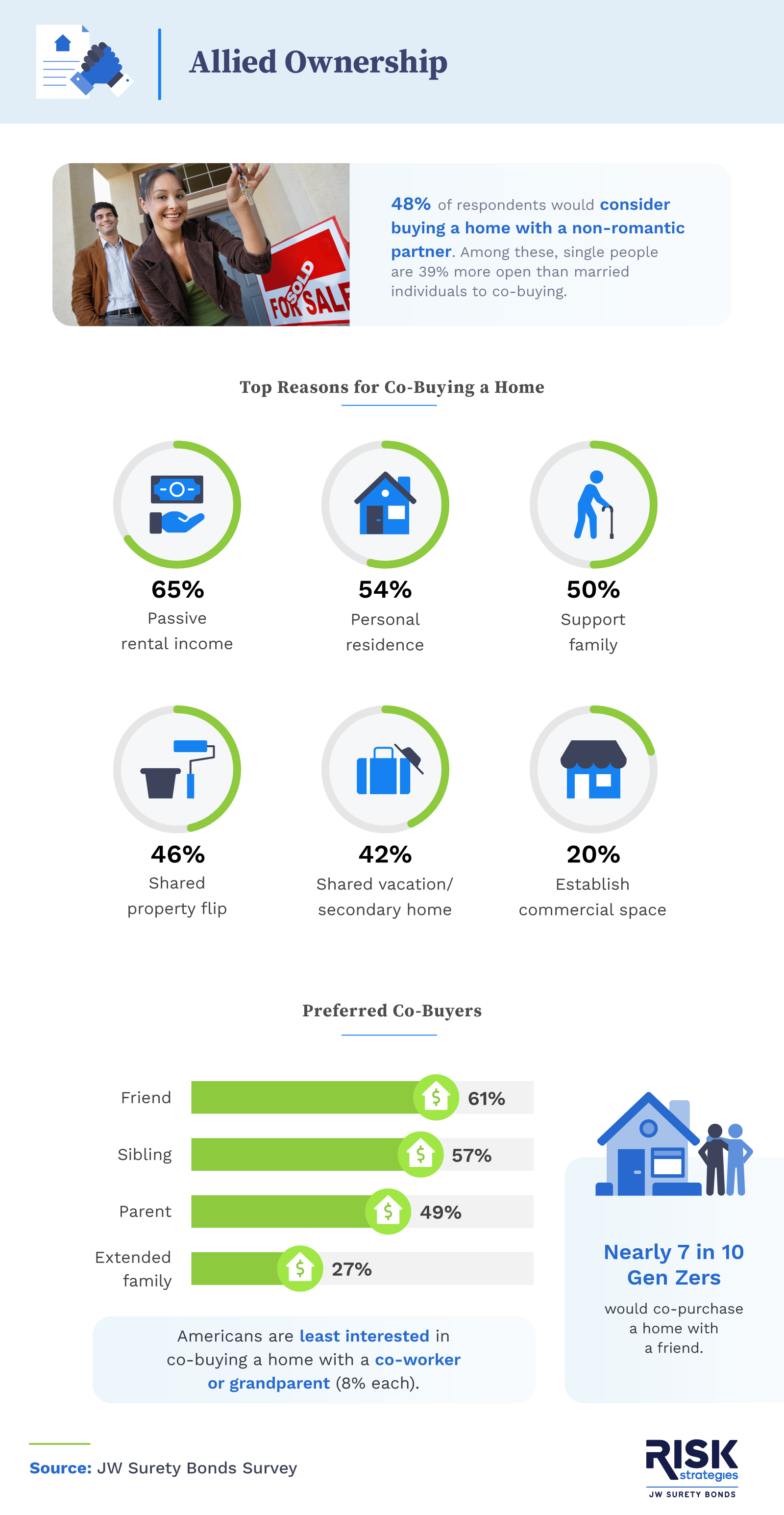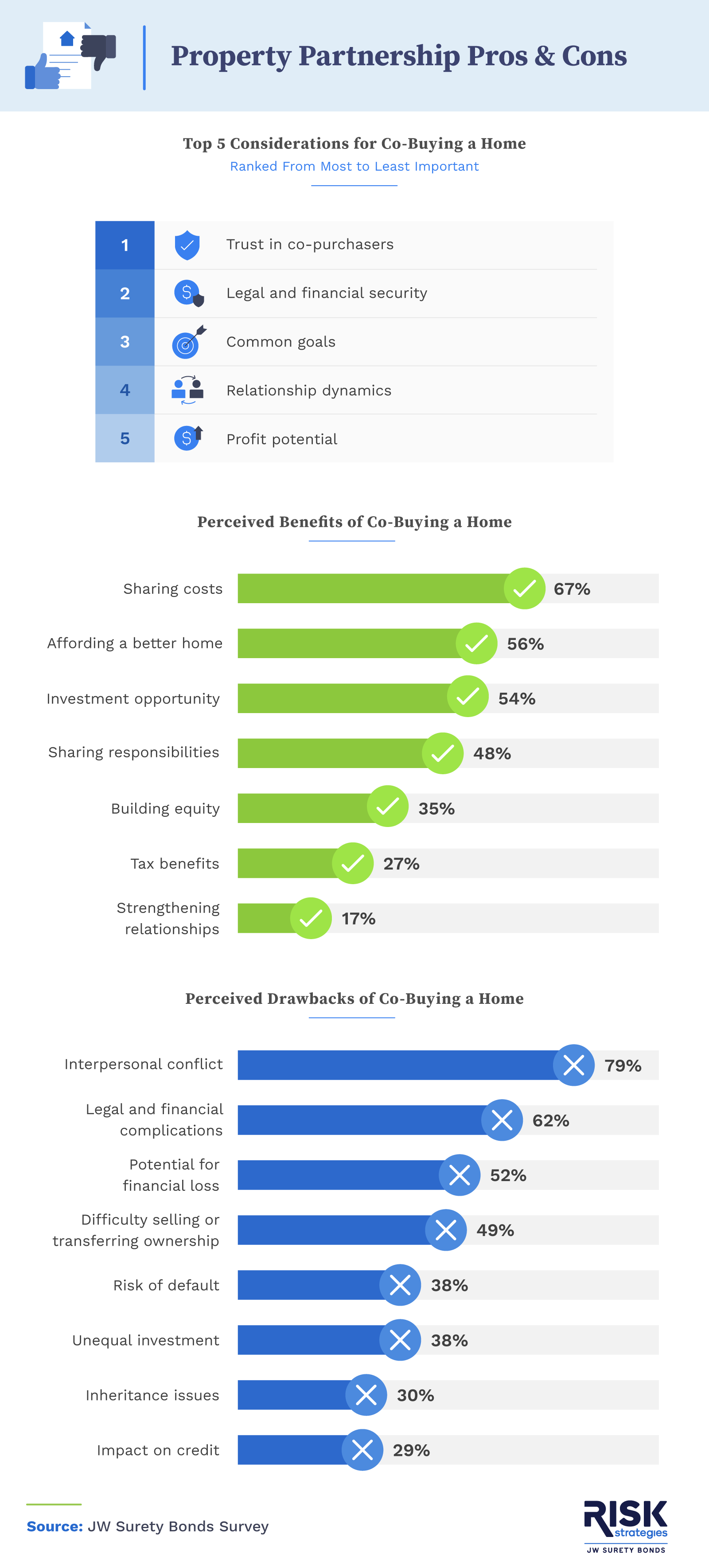
Imagine a shared home purchase that’s not a romantic venture, but a pragmatic co-investment with a friend, colleague, or family member. It’s an unconventional approach that’s gaining traction in today’s dynamic real estate market. To understand the shifting dynamics of home ownership, we surveyed 1,004 Americans, 13% of whom have stepped beyond traditional boundaries to co-purchase homes with non-romantic partners. Join us as we look into the motivations, benefits, and potential pitfalls of co-buying partnerships.
Key Takeaways
- Nearly 15% of Americans have co-purchased a home with a person other than their romantic partner, and another 48% would consider it.
- Over 6 in 10 Americans would co-buy a home with a friend, with Gen Z being the most willing (70%).
- Nearly 1 in 4 respondents who co-purchased a home with a non-romantic partner said they could not have afforded the purchase alone.
- Respondents who co-purchased a home with a non-romantic partner invested $89,484, on average.
- The biggest perceived advantages to co-buying a home are sharing costs (67%), affording a better home (56%), and investment opportunities (54%).
Unpacking the Dynamics of Co-Buying Homes

Key Takeaways
- Nearly half of respondents (48%) would consider co-purchasing a home with a person other than their romantic partner.
- Singles are 39% more likely than married individuals to be interested in co-buying a home.
- Men (47%) and women (48%) are almost equally likely to be interested in co-buying a home with someone other than a romantic partner.
- Renters are 29% more likely than homeowners to be interested in co-purchasing a home with a non-romantic partner.
- Gen Z is the most interested in co-buying a home for a personal residence (70%); older generations are most interested in doing so as an investment opportunity.
- Over 6 in 10 Americans would co-purchase a home with a friend, with Gen Z being the most willing (70%).
- Gen Z is 13% more likely to be interested in co-buying a home with a friend than with a parent.
- Men are 37% more likely than women to be interested in co-buying a home with a friend.
- Nearly 15% of Americans have co-purchased a home with a person other than their romantic partner.
- Individuals that have co-purchased a home with a non-romantic partner did so with the following:
- Parent (29%)
- Sibling (26%)
- Friend (26%)
- Nearly 1 in 4 respondents who co-purchased a home with a non-romantic partner could not have afforded to buy the home otherwise.
- Nearly half of co-buyers (49%) decided to co-purchase their primary residence. Others co-purchased as an investment, with 26% renting out the home and 17% flipping it.
- Those that co-purchased a home with a non-romantic partner invested $89,484, on average.
Balancing the Burdens of Joint Ownership

Key Takeaways
- 1 in 4 Gen Zers believe co-buying a home can strengthen relationships.
- Women are 29% more likely than men to view shared responsibilities such as maintenance and repairs as an advantage to joint ownership.
- Only 1 in 4 Gen Zers are concerned about the risk of default or uneven investment.
- Women are 11% more likely than men to be concerned about conflicts with co-buyers.
- Single people are 20% more likely than married individuals to view sharing the financial burden as an advantage to co-buying a home.
- The biggest perceived advantages to co-buying a home are sharing costs (67%), affording a better home (56%), and investment opportunities (54%).
The Changing Face of Homeownership
The concept of non-romantic co-buying is reshaping the traditional path to homeownership. Our survey revealed that a significant portion of Americans are now investing in homes with friends and family. This trend, fueled by economic factors and a generational shift in values, suggests a broader acceptance of shared financial responsibility. We might see the real estate industry evolve to accommodate this growing preference, offering more tailored co-ownership opportunities. Further research could illuminate the long-term effects of this shift on community dynamics and financial wellness.
Methodology
We surveyed 1,004 Americans about co-buying homes with non-romantic partners. Among them, 13% had bought a home with a friend or family member. The generational split was as follows: 57% millennials, 26% Gen X, 9% baby boomers, and 8% Gen Z.
About JW Surety Bonds
JW Surety Bonds is the leading surety bond provider in the United States, distinguished by our commitment to simplifying the bonding process. With a focus on delivering fast, accessible, and affordable bonding solutions, our innovative and user-friendly online platform caters to a diverse clientele across various industries.
Fair Use Statement
Share these co-buying home insights freely for any non-commercial purpose, but please credit our research with a link back to this page.



Leave a Reply